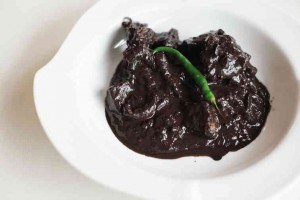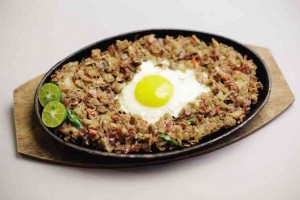
It must have been during one of the food trips organized by the late Doreen Fernandez, the Inquirer’s well-regarded food and cultural critic (and our English teacher in college), that we stopped over in a town called San Juan in Ilocos Sur to savor street barbecue.
But we weren’t there for the barbecue, but rather for the unique barbecue sauce. Instead of the usual vinegar and spices, the barbecue stick was dipped in a tall glass jar gleaming darkly with thick dinuguan (pork blood stew).
What a glorious, gooey epiphany! Dinuguan as condiment? Who would have thought of such a wicked, wondrous travesty?
But this was not enough. A few towns away, up in the flatlands of Ilocos Norte, was a restaurant across the historic Paoay Church whose specialty, we soon found out, was dinuguan pizza.
This illuminated a running theme in Doreen’s writings—that in the colonial encounter, we Filipinized the foreign and made it our own. We simply gobbled them up.

Now, dinuguan has come full circle, of sorts. When we sat down to dinner with some friends a few days ago, we were in for a surprise: crispy dinuguan. Not a condiment, not a topping, dinuguan was respected for what it was—a homey Pinoy dish partaken with kindred spirits with whom you can let your hair down (and flash your dinuguan-speckled teeth in the tête-à-tête), but with a knowing, crunchy makeover.
This was at Red Palm in Butuan City, a cozy bed-and-breakfast affair where those in the know get away from the madding crowd.
“The crispy dinuguan is our bestseller,” said Dante Verdad Reveche, Red Palm’s ebullient manager.
And why not? Instead of the slimy, chopped-up pork intestines you chew on in the usual dinuguan recipe, or the mushy, lean meat bite sizes used in updated family recipes, Red Palm’s dinuguan uses what could only be crispy pata, cut up into agreeable chunks, and then dunked into a separate preparation of the blood stew in its ready-to-serve simmering finish.
This results in a stupendous wake-upper of a dish: flavorful in a familiar way even as it questions the way things are and cracks open a taste of mind-boggling possibilities.
Playful freshness
The owner of Red Palm, Elizabeth Dy, went with us to her brother Danny’s place, Café Caliente, right on the city’s main street, Montilla Blvd., so we could try his famous Lechon Sisig.
Technically, it’s not his recipe. The credit goes to his wife, Jocelyn Jaropillo-Verdad, a Manileña born to Ilonggo parents.
Café Caliente started as a coffee shop where families could kill time while their cars were being tuned up or fixed at the nearby garage.
“Our son Danilo Jr. manages the garage and the gun store; our eldest son Dan Paulo takes care of the grocery up front; and our daughter, Joyce Angelica, the youngest, takes care of all the baking,” Jocelyn said. “I don’t like to bake because it is so exacting.”
Seafood feast
What she likes instead is to experiment. And she introduced the darn-why-didn’t-I-think-of-that-before idea of the sizzling Lechon Sisig. On our table, it shimmered with generous flecks of peek-a-boo lechon skin, glistened with the sinuous juiciness of the roasted meat, and completed its spell with that endearing, woodsy aroma.
We also tried the Pasta Pirata, a seafood feast nonpareil (pasta is Jocelyn’s specialty).
The Double Chocolate Cookie—a passionate meltdown of intensities—lingered on our palate and in our thoughts even as we slalomed inside one of the chi-chi KTV rooms at Café Caliente in the witching hours.
Elizabeth Dy and Danny Verdad are part of the triumvirate of siblings jazzing up Butuan’s food scene; in this endeavor, they are led by Rosita Dy-Dayan of Red Apple.
Mainstays
“You can say that Red Apple goes all the way back to 1954, when my parents ran the Butuan City Restaurant,” Rosita said. “The lomi and siopao of old are still our mainstays.”
Their father, Dy Tong Hai, came all the way from Amoy (Xiamen) in China. He arrived in Butuan with his Bicolano wife, Zosima nee Verdad, at the peak of the logging and mining boom in Butuan.
Their father became the go-to guy for the best Chinese food in town.
Obsession with food
The restaurant below their house would become so busy that the whole household staff would be called to pitch in, and the children would be forgotten upstairs—without food.
“Perhaps that explains our obsession with food,” Rosita laughed.
While Red Apple is popular for its Filipino breakfast and lunch fare, it is well-patronized for its cakes and kakanin, too.
The bestseller is the Kakanin sa Bilao—a fiesta fare of buko cassava, biko with latik, bibingkang malagkit, kutsinta, maja mais, pichi-pichi, sapin-sapin and ube calamay.
The ube calamay is a fusion of ube jam and that beloved pasalubong from Bohol—the calamay, or ground rice paste cooked in coconut milk and muscovado sugar. Red Palm’s incarnation is almost like dreamy, creamy ube ice cream.
Red Apple’s sweets have found their way to the US, Sweden, Japan, and the Middle East. Declared Rosita: “This is how we Pinoys conquer the world today, bite by delicious bite.”
And that’s exactly Doreen Fernandez’s point.
Call Red Palm, tel. +85-3412000; Café Caliente, tel. +85-3427496; and Red Apple, tel. +85-3425127.
PHOTOS BY RALPH FERNANDEZ AND GIGI NAPANA

